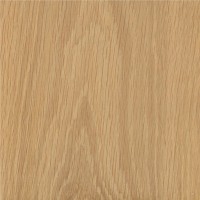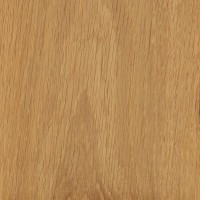 |
Common Name(s): Japanese Oak, Mongolian Oak Scientific Name: Quercus mongolica Distribution: Japan and eastern Asia Tree Size: 65-100 ft (20-30 m) tall, 2-3 ft (.6-1 m) trunk diameter Average Dried Weight: 43 lbs/ft3 (680 kg/m3) Specific Gravity (Basic, 12% MC): .64, .68 Janka Hardness: 1,200 lbf (5,320 N)* *Estimated hardness based on specific gravity Modulus of Rupture: No data available Elastic Modulus: 1,525,000 lbf/in2 (10.51 GPa) Crushing Strength: 8,290 lbf/in2 (57.2 MPa) Shrinkage: No data available |
Color/Appearance: Heartwood is a light to medium brown, commonly with an olive cast. Nearly white to light brown sapwood is not always sharply demarcated from the heartwood. Quartersawn sections display prominent ray fleck patterns. Japanese Oak is reported to have a larger percentage of sapwood and a smaller heartwood section, with lighter overall color than White Oak; ray fleck is also reported to be less pronounced.
Grain/Texture: Grain is straight, with a coarse, uneven texture.
Endgrain: Ring-porous; 2-4 rows of large, exclusively solitary earlywood pores, numerous small to very small latewood pores in radial arrangement; tyloses common (though not as prevalent as White Oak); growth rings distinct; rays large and visible without lens; apotracheal parenchyma diffuse-in-aggregates (short lines between rays).
Rot Resistance: Reports are variable; Japanese Oak tends to have a wider proportion of sapwood, which makes it more vulnerable to insects/borers, as well as wood decay.
Workability: Produces good results with hand and machine tools. Can react with iron (particularly when wet) and cause staining and discoloration. Responds well to steam-bending. Glues, stains, and finishes well.
Odor: Has a tell-tale smell that is common to most oaks. Most find it appealing.
Allergies/Toxicity: Besides the standard health risks associated with any type of wood dust, no further health reactions have been associated with Basswood. Although severe reactions are quite uncommon, oak has been reported as a sensitizer. Usually most common reactions simply include eye and skin irritation. See the articles Wood Allergies and Toxicity and Wood Dust Safety for more information.
Pricing/Availability: No data available.
Sustainability: This wood species is in CITES Appendix III, but is not on the IUCN Red List.
Common Uses: Boatbuilding, tight cooperage (whiskey barrels), veneer, and furniture.
Comments: Japanese Oak tends to have a slower growth rate than other temperate species of Europe or North America. As a result, the wood tends to be slightly lighter and weaker (on account of its increased proportion of earlywood pores) than standbys such as White Oak, though this also gives the wood more uniformity and easier workability.
- Black Oak (Quercus velutina)
- Bog Oak
- Brown Oak
- Bur Oak (Quercus macrocarpa)
- California Black Oak (Quercus kelloggii)
- Cherrybark Oak (Quercus pagoda)
- Chestnut Oak (Quercus prinus)
- English Oak (Quercus robur)
- Holm Oak (Quercus ilex)
- Laurel Oak (Quercus laurifolia)
- Live Oak (Quercus virginiana)
- Oregon White Oak (Quercus garryana)
- Overcup Oak (Quercus lyrata)
- Pin Oak (Quercus palustris)
- Post Oak (Quercus stellata)
- Red Oak (Quercus rubra)
- Scarlet Oak (Quercus coccinea)
- Sessile Oak (Quercus petraea)
- Shumard Oak (Quercus shumardii)
- Southern Red Oak (Quercus falcata)
- Swamp Chestnut Oak (Quercus michauxii)
- Swamp White Oak (Quercus bicolor)
- Turkey Oak (Quercus cerris)
- Water Oak (Quercus nigra)
- White Oak (Quercus alba)
- Willow Oak (Quercus phellos)
Scans/Pictures: There are currently no pictures of this exact wood species, but a similar species within the Quercus genus is being substituted (Q. alba). If you’d like to contribute a wood sample of this specific species to be scanned, (even small pieces of veneer can be sent), please use the contact form.
 |
 |





Hi ,
Earlier I put this in your ‘how to tell white oak from red oak’ thread but it looks like it may also be appropriate here.
I live in Japan and have two bokuto (wooden practice swords) made by the Aramaki workshop.
https://www.seidoshop.com/blogs/the-seido-blog/51-an-interview-with-master-aramaki-bokken-artisan
In the photo below, the 15 year old example on the right is definitely white Japanese oak while the 37 year old bokuto on the left could be either white OR red Japanese oak.
I really enjoyed this article, Simon! Thanks for sharing it!
Japanese oak was used for decades in the construction of very high end furniture by a company called Laidler. Laidler was a Vancouver based company. I have a side table made from Japanese oak and it is heavy.
I have been cutting lumber for about 17 years now and today I cut a very unusual species. We were told that it was a Japanese wood that brought good money when cut into boards. It had a faint peanut butter smell when being cut that went to a dill pickle smell once it started drying. It has a beautiful grain but cut like butter. Oak does not cut that easy even on a resharpend blade. It is even lighter in wait than oak.
https://www.wood-database.com/ailanthus/
Tree-of-Heaven, from the way you described the smell, color, and cutting quality, though I can’t be sure without a picture
I have some boards that I am trying to find out what they are. Beautiful grain and definitely hard. One guy on a forum said Japanese Oak. They were from rough cut 2X4s in a pallet used for heavy machinery from Taiwan. They are easy to work with and polish up beautifully.
Thanks for any info you can share.
they are Cyclobalanopsis morii, usually made into planer
It would be awesome if you could get your hands on some Japanese evergreen oaks and test them out, I’m very curious of how hard they are. I wonder if it’s about the same hardness as southern live oak. ?
Seido identifies Japanese White Oak as “Quercus acutissima”.
I couldn’t find that species in your database.
Do you have any info about the differences?
(see https://www.seidoshop.com/pages/choosing-bokken-jo-woods)
Thanks Shelby, went to that website, a lot of fascinating information.